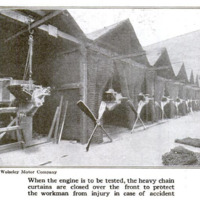Testing Airplane Engines Behind Chain Curtains
Item
-
Title (Dublin Core)
-
Testing Airplane Engines Behind Chain Curtains
-
Article Title and/or Image Caption (Dublin Core)
-
Testing Airplane Engines Behind Chain Curtains
-
extracted text (Extract Text)
-
THE airplane engine is a wonderful
piece of mechanism. It must be
compact, because space in the fuselage
is extremely limited. It must be light
in proportion to the horsepower de-
veloped.
Try to imagine an engine capable of
developing one hundred
and thirty-two horsepower
which weighs only one
hundred and ninety-four
pounds. Not all engines
are equally light in com-
parison to their horsepower,
but only in a few of the
largest and heaviest types
does the relative weight
exceed two or three pounds
per horsepower. That
means that the material
must be able to withstand
enormous strain while the
engine is working under
extremely high pressure —
as high as one hundred and
twenty-nine pounds to the
square inch and making
from twelve hundred to
twenty-one hundred revo-
lutions a minute. Think
of the terrific strain upon
the engine and its propeller
cleaving the thin air in high altitudes
at maximum speed, and you will under-
stand that an engine upon which such
extreme demands are made must be
thoroughly tested before it is placed in
commission.
Every airplane engine must be
tested under running conditions;
therefore, in all factories where large
numbers of such engines are built,
special provisions must be made for
protecting the life and limb of me-
chanics engaged in making the tests.
There may be the slightest defect in
the material, a defect so
minute that it escapes the
scrutiny of the eagle-eyed
inspectors, a weak spot or a
lack of proper adjustment
which manifests itself with
startling vehemence during
the test. A pipe or a
cylinder may burst; the
crank-shaft may break; the
propeller may fly to pieces.
In the airplane factory of
an English company every
engine to be tested is
temporarily mounted on a *
framework in one of the
stalls, the sides and fronts
of which are made of heavy
chain curtains, - Protected
by these curtains, the
workmen and engineers
can observe the working of
the engine without risk of
injury should the propeller
fly to pieces.
-
Contributor (Dublin Core)
-
Wolseley Motor Company (image copyright)
-
Language (Dublin Core)
-
eng
-
Date Issued (Dublin Core)
-
1919-10
-
pages (Bibliographic Ontology)
-
56
-
Rights (Dublin Core)
-
Public domain (Google digitized)
-
Archived by (Dublin Core)
-
Davide Donà
-
Alberto Bordignon (Supervisor)
 Popular Science Monthly, v. 95, n. 4, 1919
Popular Science Monthly, v. 95, n. 4, 1919
 1.png
1.png
